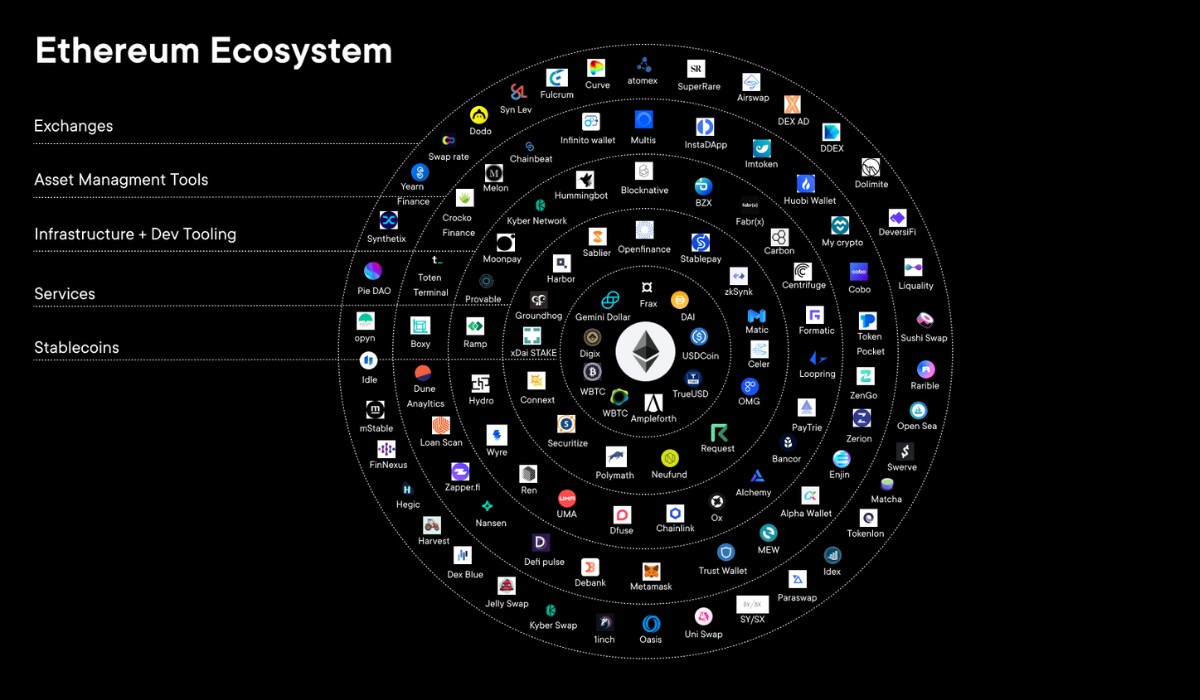Introduction
Welcome to the world of blockchain technology, where decentralized networks and cryptocurrencies have taken the financial and technological industries by storm. One prominent blockchain that has gained a significant amount of attention and popularity is Ethereum. As one of the leading blockchain platforms, Ethereum has revolutionized the way we conduct transactions and build decentralized applications (DApps).
But have you ever wondered just how big the Ethereum blockchain is? In this article, we will delve into the size of the Ethereum blockchain, the factors that contribute to its growth, and the implications of its size on the Ethereum ecosystem.
Before we dive into the specifics, let’s first understand what the Ethereum blockchain is and how it functions.
Ethereum is an open-source blockchain platform that enables developers to build and deploy smart contracts and decentralized applications. Unlike Bitcoin, which primarily serves as a digital currency, Ethereum’s blockchain serves as a decentralized platform that runs applications without the risk of censorship, downtime, or third-party interference.
At its core, Ethereum operates on the principles of decentralization, immutability, and transparency. It achieves this through a network of computers, known as nodes, that collectively maintain the blockchain. Each node stores the entire Ethereum blockchain, ensuring that the network remains resilient and tamper-proof.
Now that we have a basic understanding of Ethereum, let’s delve into the size of its blockchain. As with any blockchain, the size of the Ethereum blockchain refers to the amount of data stored within it. This data includes transaction history, smart contracts, and other metadata that make up the Ethereum ecosystem.
Understanding the size of the Ethereum blockchain is crucial for various reasons. Firstly, it provides valuable insights into the growth and scalability of the network. Additionally, it helps developers and users gauge the resources required to interact with the blockchain effectively.
In the following sections, we will explore the factors that contribute to the size of the Ethereum blockchain, the growth rate of the blockchain, and how to check the size of the Ethereum blockchain. We will also discuss the implications of a large blockchain size and steps taken to manage it efficiently.
What is Ethereum Blockchain?
The Ethereum blockchain is a decentralized, distributed ledger that acts as the foundation for the Ethereum platform. It serves as a digital infrastructure for running smart contracts and decentralized applications (DApps). Unlike traditional centralized systems, Ethereum’s blockchain operates on a peer-to-peer network, enabling participants to interact directly without the need for intermediaries.
At its core, Ethereum utilizes a virtual machine called the Ethereum Virtual Machine (EVM), which executes smart contracts. These smart contracts are self-executing agreements with predefined rules and conditions, enabling automatic and trustless transactions. The Ethereum blockchain records and validates these transactions, providing transparency and security to its users.
One of the key features that sets Ethereum apart from other blockchains is its support for programmable transactions. Smart contracts on the Ethereum platform can execute complex logic and perform computations based on predefined conditions. This functionality enables the development of decentralized applications, ranging from financial services to supply chain management, gaming, and much more.
The Ethereum blockchain also has its native cryptocurrency called Ether (ETH). Ether serves as the fuel for the Ethereum network, providing incentives for miners to verify and add transactions to the blockchain. Furthermore, Ether acts as a medium of exchange within the Ethereum ecosystem, allowing users to pay for services and interact with smart contracts.
By utilizing blockchain technology, Ethereum ensures that all transactions and smart contracts are transparent, secure, and immutable. The blockchain’s decentralized nature eliminates the need for intermediaries, reducing costs and increasing efficiency. Additionally, the Ethereum blockchain allows for seamless peer-to-peer transactions, enabling cross-border payments without the need for traditional banking systems.
Overall, the Ethereum blockchain revolutionizes the way transactions are conducted and applications are built. Its decentralized, programmable, and secure nature empowers individuals and businesses to create, deploy, and interact with decentralized applications, opening up a world of possibilities for innovation and disruption across various industries.
How does Ethereum Blockchain work?
The Ethereum blockchain operates on a decentralized network of nodes that collectively maintain the integrity and security of the blockchain. These nodes are computers that participate in the Ethereum network, and each node stores a copy of the entire Ethereum blockchain. Let’s take a closer look at how the Ethereum blockchain works:
1. Transactions: When a user initiates a transaction on the Ethereum network, it is broadcasted to all the nodes on the network. These transactions include the transfer of Ether (ETH) or the execution of a smart contract.
2. Verification: The nodes on the network verify the transaction’s legitimacy by checking if the sender has sufficient funds and if the transaction adheres to the rules and conditions defined by the smart contract, if applicable.
3. Block Formation: Validated transactions are grouped together into blocks. Each block contains a unique identifier called a hash and a reference to the previous block’s hash, creating a chain of blocks, hence the term “blockchain.”
4. Consensus Mechanism: The Ethereum network utilizes a consensus mechanism called Proof-of-Work (PoW) to validate and add new blocks to the blockchain. Miners compete to solve complex mathematical problems, and the first miner to solve the problem receives a reward in the form of newly created Ether and transaction fees.
5. Block Validation: Once a miner successfully solves the mathematical problem, the proposed block is broadcasted to the network. Other nodes verify the block and ensure that it satisfies all the necessary conditions, including the validity of transactions and the correct execution of smart contracts.
6. Block Addition: If the majority of the network’s nodes agree that the proposed block is valid, it is added to the blockchain. Once added, the block becomes a permanent part of the Ethereum blockchain and cannot be altered or removed.
7. Chain Extension: New blocks are added to the end of the chain, extending the blockchain. This process continues as new transactions occur, creating an ever-growing chain of blocks.
8. Network Consistency: With the participation of numerous nodes, the Ethereum network ensures the consistency and integrity of the blockchain. By maintaining a decentralized network, the Ethereum blockchain becomes highly resistant to censorship and single points of failure.
9. Smart Contract Execution: Smart contracts are self-executing agreements that run on the Ethereum Virtual Machine (EVM). When a smart contract is triggered by a transaction, the EVM executes the code and carries out the desired actions as stipulated within the contract.
Through this decentralized and consensus-driven process, the Ethereum blockchain facilitates secure, transparent, and efficient transactions on a global scale. It enables the development and deployment of decentralized applications, fostering innovation and transforming traditional business models across various industries.
Size of Ethereum Blockchain
As the Ethereum network continues to grow and attract more participants, the size of the Ethereum blockchain steadily increases. The size of the Ethereum blockchain refers to the amount of data stored within it, including transaction history, smart contracts, and other metadata that make up the Ethereum ecosystem.
The exact size of the Ethereum blockchain can vary over time, but as of [current date], it is estimated to be around [size] in terms of storage space. This size is continuously expanding as new blocks are added to the chain and more transactions and smart contracts are recorded.
It’s important to note that the size of the Ethereum blockchain is not static. With each new block added to the chain, the size grows incrementally. This growth is crucial to maintaining the integrity and transparency of the network.
The size of the Ethereum blockchain has several implications. Firstly, it affects the storage requirements for running a full node on the network. As the blockchain grows larger, the storage space required to maintain a complete copy of the chain increases. This can be a consideration for individuals or organizations looking to participate in the Ethereum network by running a node.
Additionally, the size of the blockchain can impact the time it takes to synchronize a new node with the network. Nodes need to download and verify every block in the chain to ensure the validity of the transactions. The larger the blockchain, the longer this synchronization process can take.
Another consequence of a large blockchain size is the increased bandwidth and processing power required to transmit and validate transactions. Miners and nodes need to handle larger amounts of data, which can have implications for network scalability and performance.
While the size of the Ethereum blockchain may present challenges in terms of storage, synchronization, and resource requirements, efforts are being made to address these issues. Various scaling solutions, such as Ethereum 2.0 and Layer 2 protocols, are being developed to improve the efficiency and scalability of the network.
It is worth mentioning that the size of the blockchain may not be a concern for all users or developers. Light clients and third-party applications can interact with the Ethereum network without storing the entire blockchain, relying on trusted nodes or specific data subsets.
Overall, the size of the Ethereum blockchain is a dynamic aspect of the network. It reflects the growth and adoption of the platform and plays a role in determining the resources required to participate in the Ethereum ecosystem.
Factors contributing to the size of Ethereum Blockchain
The size of the Ethereum blockchain is influenced by various factors that contribute to the accumulation of data within the network. Understanding these factors is essential for comprehending the growth and scalability of the Ethereum blockchain. Here are the key factors that contribute to the size of the Ethereum blockchain:
1. Transaction Volume: As one of the most widely used blockchain platforms, Ethereum handles a significant number of transactions on a daily basis. Each transaction recorded on the blockchain adds to the overall size of the Ethereum network. The higher the transaction volume, the faster the blockchain expands.
2. Smart Contract Deployments: Ethereum’s support for smart contracts has fueled the development of a multitude of decentralized applications (DApps). Each time a developer deploys a smart contract on the Ethereum network, it contributes to the size of the blockchain. Smart contracts can be complex and involve code execution, storage of variables, and event logs, all of which occupy storage space on the blockchain.
3. Token Creation: Ethereum allows users to create their own tokens using the ERC-20 standard or other token standards. These tokens represent various assets, utilities, or ownership rights. The creation and subsequent use of these tokens contribute to the growth of the Ethereum blockchain. Each token transfer and associated metadata consume storage space on the blockchain.
4. Decentralized Finance (DeFi) Platforms: DeFi has gained significant traction on the Ethereum network, with a wide array of lending, borrowing, and trading platforms being developed. The growth of DeFi contributes to increased transaction volume, smart contract deployments, and token interactions, all of which lead to a larger blockchain size.
5. Block Size and Gas Limit: Each block in the Ethereum blockchain has a maximum size and gas limit. The gas limit determines the computational resources allocated to executing transactions and smart contracts. If a block nears its gas limit, a new block is created and appended to the chain, resulting in the expansion of the blockchain size.
6. Data Storage within Smart Contracts: Smart contracts can include storage variables that hold data relevant to their functioning. As more data is stored within smart contracts, such as user information or application-specific data, the overall size of the blockchain increases.
7. Network Adoption and Activity: The growth of the Ethereum network through increased adoption and activity by users, developers, and enterprises directly impacts the size of the blockchain. A thriving ecosystem leads to more transactions, smart contracts, and token interactions, amplifying the accumulation of data on the blockchain.
8. Network Upgrades and Improvements: As Ethereum continues to evolve, network upgrades and improvements may introduce changes that affect the size of the blockchain. For example, the upcoming Ethereum 2.0 upgrade aims to introduce a more scalable and efficient infrastructure, which could have implications for the size of the blockchain.
These factors collectively contribute to the growth of the Ethereum blockchain. As the platform continues to see increased usage and development, it is expected that the size of the blockchain will continue to expand. It is crucial for the Ethereum community to recognize and address these factors to ensure the long-term scalability and efficiency of the network.
Growth rate of Ethereum Blockchain
The growth rate of the Ethereum blockchain is a reflection of the increasing adoption and usage of the Ethereum network. As more transactions, smart contracts, and decentralized applications (DApps) are created and deployed, the blockchain expands to accommodate the growing data on the platform. Let’s explore the factors that contribute to the growth rate of the Ethereum blockchain:
1. Transaction Volume: The number of transactions processed on the Ethereum network has a direct impact on the growth rate of the blockchain. As more users and businesses utilize Ethereum for various purposes, such as conducting peer-to-peer transfers or interacting with DApps, the transaction volume increases, leading to a faster growth rate of the blockchain.
2. DApp Development: Ethereum’s capability to support the creation of DApps has resulted in a vibrant ecosystem of decentralized applications. The development and deployment of DApps contribute to the growth rate of the Ethereum blockchain, as each DApp interacts with the blockchain and generates transactions and smart contract interactions.
3. Token Activity: Ethereum allows for the creation and use of tokens on its blockchain, which has led to the rise of numerous tokenized projects and use cases. The activity associated with these tokens, such as transfers, token swaps, and utilization in DeFi platforms, all contribute to the growth rate of the blockchain.
4. DeFi Adoption: The rapid growth of decentralized finance (DeFi) on Ethereum has had a profound impact on the growth rate of the blockchain. DeFi platforms, such as decentralized exchanges, lending protocols, and yield farming projects, generate a significant number of transactions and interactions, resulting in an accelerated growth rate of the Ethereum blockchain.
5. Smart Contract Deployments: Smart contracts play a vital role in the Ethereum ecosystem, as they provide the foundation for various DApps and token functionalities. The continuous deployment of smart contracts, whether for new projects or updates to existing contracts, contributes to the growth rate of the blockchain.
6. Network Upgrades: Ethereum undergoes regular upgrades and improvement proposals to address scalability, security, and efficiency concerns. These network upgrades, such as the upcoming Ethereum 2.0, aim to enhance the overall performance of the blockchain. While these upgrades may introduce temporary slowdowns in the growth rate due to network adjustments, they are ultimately designed to support a sustainable and scalable blockchain ecosystem.
7. Increased User Adoption: The growth rate of the Ethereum blockchain is ultimately driven by the increasing number of users and entities participating in the network. As more individuals, businesses, and developers recognize the potential of Ethereum and participate in its ecosystem, the blockchain experiences a higher growth rate due to the accumulation of data from their interactions.
The growth rate of the Ethereum blockchain is indicative of the expanding use cases and popularity of the platform. As Ethereum continues to evolve and accommodate new developments, it is paramount to address scalability and network efficiency concerns to ensure sustainable growth and a seamless user experience.
How to check the size of Ethereum Blockchain?
Checking the size of the Ethereum blockchain can provide valuable insights into the growth and storage requirements of the network. Several methods and tools are available to determine the size of the Ethereum blockchain. Here are some ways to check the size:
1. Ethereum Block Explorer: Block explorers, such as Etherscan and Etherchain, provide detailed information about the Ethereum blockchain, including its size. By visiting these websites and navigating to the blockchain section, users can find statistics related to the size of the blockchain, including the total size in gigabytes or terabytes.
2. Ethereum Node Software: Running an Ethereum node allows users to interact with the blockchain directly and obtain real-time information about its size. Ethereum node software, like Geth or Parity, provide commands and APIs to access blockchain data. By executing specific commands or utilizing APIs, users can retrieve the current size of the blockchain. For example, using the “eth.syncing” command in Geth provides information about the blockchain’s size and synchronization progress.
3. Command-Line Tools: There are command-line tools available, such as “ethereumetl” or “ethstats,” which allow users to analyze and retrieve data from the Ethereum blockchain. These tools can provide insights into the blockchain’s size, growth rate, and other relevant statistics.
4. Community Forums and Discussions: Online communities, such as Ethereum subreddits or Ethereum-focused forums, often discuss the size and growth of the blockchain. Engaging in these discussions can provide valuable information and insights from users and experts within the Ethereum community.
5. Developer APIs: Many blockchain data providers offer APIs that allow developers to retrieve blockchain-related information, including the size of the Ethereum blockchain. By utilizing these APIs, developers can integrate blockchain size data into their applications or tools.
It’s important to note that the size of the Ethereum blockchain can vary between different sources and tools due to factors such as time of measurement or the way data is calculated. Additionally, the Ethereum blockchain’s size continues to grow as new blocks are added, so checking the size periodically can provide a more accurate representation of its current state.
By using these methods and tools, users, developers, and researchers can monitor and keep informed about the size and growth of the Ethereum blockchain. Understanding the size of the blockchain is essential for resource planning, network management, and ensuring the scalability and efficiency of the Ethereum network.
Managing the size of Ethereum Blockchain
As the Ethereum blockchain continues to grow, managing its size becomes crucial to ensure network efficiency, scalability, and accessibility for participants. Here are some methods and strategies employed to manage the size of the Ethereum blockchain:
1. Pruning: Pruning is a technique used to reduce the size of the blockchain by removing older or unnecessary data while retaining the essential information for the network’s functionality. With pruning, nodes can maintain a lighter version of the blockchain, preventing it from growing excessively large. This process helps optimize storage and improves synchronization time for new nodes joining the network.
2. State Channel Solutions: State channels enable off-chain transactions between participants while utilizing the security of the Ethereum blockchain. By executing frequent or high-volume transactions off-chain and settling the final outcome on the blockchain, state channel solutions reduce the amount of on-chain data, effectively managing the blockchain’s size and congestion.
3. Layer 2 Scalability Solutions: Layer 2 solutions, such as sidechains and scaling protocols like Plasma and Optimistic Rollups, provide additional processing capacity and reduce the load on the main Ethereum blockchain. These solutions enable the execution and settlement of transactions off-chain, minimizing the strain on the main network and helping manage the blockchain’s size.
4. Improving Block Propagation: Optimizing block propagation mechanisms within the Ethereum network can enhance the efficiency of transmitting and validating new blocks. By reducing block propagation time and improving information dissemination across nodes, the network can handle a larger number of transactions and smart contracts, effectively managing the growth rate of the blockchain.
5. Network Upgrades: Upgrading the Ethereum network with protocol improvements and enhancements is another approach to managing the size of the blockchain. Consensus algorithm changes, sharding, and the transition to Ethereum 2.0 are intended to enhance scalability, reduce network congestion, and manage the blockchain’s size more effectively.
6. Data Compression Techniques: Applying data compression techniques can effectively reduce the storage requirements and bandwidth usage of the Ethereum blockchain. Compressing the blockchain’s data without compromising its integrity or security enables more efficient storage and transmission, contributing to the overall management of the blockchain’s size.
7. Offloading Non-essential Data: Some data on the Ethereum blockchain may not be crucial for the network’s functionality, such as older smart contract logs or historical transaction data. Offloading or archiving non-essential data to separate storage systems or decentralized storage networks helps reduce the size of the blockchain while maintaining accessibility to the relevant information when needed.
By implementing these management strategies and continuing research and development, the Ethereum community aims to strike a balance between maintaining the blockchain’s integrity and scalability while managing its size efficiently.
Efforts to optimize storage, enhance network performance, and leverage scalability solutions are critical for ensuring the Ethereum blockchain remains accessible, resilient, and adaptable to future advancements in blockchain technology.
Implications of a large Ethereum Blockchain size
The size of the Ethereum blockchain has several implications for its users, developers, and the overall blockchain ecosystem. As the blockchain grows larger, it poses certain challenges and considerations that can impact its functionality and accessibility. Here are some of the key implications of a large Ethereum blockchain size:
1. Storage Requirements: A larger blockchain size necessitates more storage space to maintain a complete copy of the blockchain. Miners, node operators, and users running full nodes need to allocate sufficient storage resources to accommodate the expanding blockchain. This can be a challenge for individuals with limited storage capacity or those operating on devices with restricted storage capabilities.
2. Synchronization Time: When new nodes join the Ethereum network or existing nodes go offline and need to catch up with the blockchain’s latest state, a larger blockchain size increases the time required for synchronization. Nodes must download, validate, and process every block to reach the current state of the blockchain, which can be time-consuming, especially for slower or less powerful devices.
3. Network Bandwidth: As the blockchain grows larger, the amount of data transferred across the network increases. This can put greater strain on network bandwidth, affecting the speed and efficiency of transaction processing and propagation. Miners and nodes may experience longer block propagation times, potentially leading to network congestion and slower confirmation of transactions.
4. Resource Intensive Operations: When interacting with the Ethereum blockchain, resource-intensive operations such as querying historical data or searching for specific transaction details can be more time-consuming and resource-intensive when dealing with a larger blockchain size. Developers and applications processing large amounts of data may require additional computational resources to maintain efficiency.
5. Centralization Pressures: A large blockchain size can create centralization pressures as running and maintaining a full node becomes more resource-intensive. Individuals or entities with limited resources may rely on light clients or third-party services to interact with the blockchain, potentially compromising the network’s decentralized architecture. Centralization can weaken the security and resilience of the blockchain network.
6. Scalability Challenges: A larger blockchain size can present scalability challenges for the Ethereum network. As the number of transactions and smart contracts increases, the blockchain’s size grows, potentially impacting the network’s ability to handle a higher transaction volume and maintain low fees. Network upgrades and scaling solutions are necessary to address these challenges and ensure the continuous scalability of the Ethereum blockchain.
7. Long-term Data Storage: With a larger blockchain size, long-term data storage becomes more critical. The Ethereum blockchain contains a wealth of historical data, including transaction history and smart contract information. Proper mechanisms and storage solutions should be in place to ensure the preservation and accessibility of this valuable historical data for future research, analysis, and audit purposes.
Addressing these implications requires a combination of technological advancements, network optimizations, and community collaboration. Scaling solutions, network upgrades, and efficient data management strategies are essential to mitigate the challenges posed by a large Ethereum blockchain size and ensure the continued growth and success of the Ethereum ecosystem.
Conclusion
The Ethereum blockchain, with its decentralized nature and support for smart contracts, has brought about a new era of innovation and possibilities in the world of blockchain technology. As the adoption and usage of Ethereum continue to increase, the size of its blockchain also expands, driven by factors such as transaction volume, smart contract deployments, and network activity.
Although the size of the Ethereum blockchain poses certain challenges and implications, such as storage requirements, synchronization time, and network scalability, the Ethereum community is actively working on solutions to address these concerns. Pruning, layer 2 scalability solutions, and network upgrades like Ethereum 2.0 are being developed to optimize storage, enhance performance, and improve scalability.
Efforts to manage the size of the blockchain are crucial to ensure the accessibility and efficiency of the Ethereum network. By employing pruning techniques, embracing off-chain solutions, and implementing data compression techniques, the blockchain’s growth can be effectively managed without compromising its integrity and security.
It is essential for users, developers, and researchers to stay informed about the size and growth rate of the Ethereum blockchain. This understanding enables better resource planning, network management, and decision-making within the Ethereum ecosystem.
As the Ethereum blockchain continues to evolve and adapt, it is important for the community to collaborate on implementing solutions that strike a balance between maintaining a robust, decentralized network and managing the blockchain’s size efficiently. With ongoing advancements and improvements, the Ethereum blockchain is poised to continue leading the way in decentralized applications, smart contracts, and blockchain innovation.

























